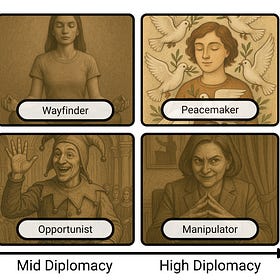From Dollhouse to LEGO Bricks: Why Patterns Beat Frameworks
A complete guide to designing your own pattern language
You've been there: explaining another organizational framework to glazed-over eyes, knowing you're just rearranging pieces in someone else's predetermined solution. What if instead of forcing your messy, human organization into a rigid framework, you could build something custom-fit from proven building blocks? The difference between success and frustration often comes down to understanding one distinction: dollhouse versus LEGO bricks. Framework versus pattern language.
Consultants, coaches, and work designers drowning in complexity sometimes grab the nearest organizational framework, such as Scrum, SAFe, LeSS, OKRs, Holacracy, or the "Spotify Model", desperate for salvation and pain relief. But standard frameworks are intellectual dollhouses—nice to look at but ultimately limiting. You can rearrange the furniture, but you're still stuck in someone else's architectural vision of the future of work.
Pattern languages? That's a different game entirely.
As I argue in my book Human Robot Agent, pattern languages beat frameworks. Think LEGO instead of Playmobil. You get the raw bricks and the freedom to develop something that actually serves your purpose. Better yet, you don't need to use every brick in the box. Simple designs often crush elaborate ones.
Welcome to The Maverick Mapmaker — where M-shaped, multidisciplinary professionals learn how to orchestrate work between humans and AI. If you refuse to be put in one box… if your mix of skills is your edge… if you want tactics for thriving in the age of AI without falling for hype or doom — this is your place. Stay sharp, stay multidisciplinary, and stay ahead. Subscribe to my Substack.
So, what is a pattern language?
It's a collection of good practices (building blocks) that you can apply either individually or in endless combinations. Team Topologies, Liberating Structures, Sociocracy 3.0, ScrumPLoP, and the unFIX Model are all examples of pattern collections.
With a pattern language, you start with nothing, and you add only what you need. (With a framework, you install the whole thing and then rip out the parts you don't need. In many framework implementations, people forget that last part.)
Pattern Languages versus Libraries
A pattern language is choreographed complexity—individual patterns working together to solve interconnected problems. In Christopher Alexander's world-famous pattern language for urban planning and architecture, patterns like Promenade, Public Square, and Building Edge don't just exist separately; they enable relationships that generate vibrant, human-centered environments.
A pattern library is your trusty toolkit. Management 3.0 is a good example. Each practice addresses a specific problem in a particular context. Libraries deliver consistency and efficiency, but they lack the grammatical relationships that make pattern languages powerful against truly wicked challenges.
Think of it this way: A pattern library is your dictionary—practical, ordered, ready for use. A pattern language is your narrative guide, showing how everything fits together. The first helps you pick better words; the second helps you write poetry.
This distinction matters because our real challenges—digital transformation, organizational design, anything worth doing—are never isolated problems requiring single solutions. They're interconnected systems demanding connected responses. Understanding this difference, and the elements that make pattern languages work, transforms how we approach complex problems.
"A pattern library is your dictionary—practical, ordered, ready for use. A pattern language is your narrative guide, showing how everything fits together. The first helps you pick better words; the second helps you write poetry."
Got it?
Right. Now, let's have a look at the language of pattern languages—how delightfully meta!
The Anatomy of Pattern Languages
I've analyzed pattern libraries and languages across various disciplines—from Alexander's architectural work to software design patterns to organizational collections of patterns. Here, I describe the core elements that make them work here, in logical order, from creation to consumption.
For improved understanding, let's use the WIP limit (borrowed from Kanban) throughout this article, so you can see how we can turn it from a practice into a formal pattern.
Number (optional)
A unique identifier for each pattern. Most pattern languages skip this, but it helps with referencing patterns in extensive collections, especially when pattern names might evolve. Not essential, but useful for organization nerds with a hint of OCD, like me.
Example: Pattern #23
Title/Name (essential)
Every pattern needs a memorable, descriptive identifier. This isn't labeling—it's vocabulary creation. When teams can say, "We need a Value Stream Crew here" or "This calls for a Facade pattern," they're using the language efficiently. Names enable rapid communication and create persistent mental models.
Example: "Work In Progress Limits" or "WIP Limits"
Symbol/Icon (optional)
Visual identifiers—icons, illustrations, card designs. Most pattern languages ignore this, but it aids recognition and memory. Think visual learners and rapid pattern identification in complex environments.
Example: A traffic light icon or funnel symbol representing controlled flow
Headline/Intent/Purpose (valuable)
Concise tagline capturing what the pattern accomplishes. More specific than the title, shorter than the full solution. About half of pattern languages use this. Helps readers grasp the essence before diving into details.
Example: "Constrain work in progress to improve flow and focus"
Also Known As (optional)
Alternative names or synonyms. Rarely used (only in Gamma's Design Patterns and in the unFIX model), but valuable when patterns have different names in different communities or when merging pattern languages.
Example: WIP Constraints, Flow Limits, Capacity Limits, Kanban Limits
Introduction (optional)
Brief narrative or context-setting, sometimes an anecdote illustrating the situation. Only appears in Fearless Change, but helps readers connect emotionally before getting to the technical details.
Example: "Sarah's team was drowning. With 47 tasks 'in progress,' nothing ever seemed to finish..."
Context/Applicability (essential)
Situations where the pattern applies—the preconditions that make it relevant. Context prevents misapplication and helps practitioners recognize familiar problems. Without a clear context, patterns become abstract theories rather than practical tools.
Example: Teams doing knowledge work with visible workflow, especially when multitasking is causing delays
Forces (valuable)
Underlying tensions, constraints, or conflicting requirements shaping the problem. Forces help practitioners understand what must be balanced. Essential for complex problems where multiple factors compete simultaneously. Used in about 50% of pattern languages.
Example: Desire to start new work vs. need to finish existing work; individual productivity vs. team throughput; responsiveness vs. focus
Problem/Motivation (essential)
The recurring challenge or design dilemma the pattern addresses. Often includes empirical evidence and real-world observations about why the problem matters. Understanding the problem deeply is a prerequisite for applying any solution meaningfully.
Example: Teams take on too many tasks simultaneously, causing context switching, longer cycle times, and delayed delivery
Solution/Design (essential)
The recommended approach, strategy, or design addressing the problem. This is the actionable core—what you actually do when encountering this situation.
Example: Set explicit numerical limits on work items allowed in each workflow stage and enforce them strictly
Rationale/Why (valuable)
Explanation of why the solution works and how it resolves competing forces. Deepens understanding beyond "what" to "why." Particularly valuable when patterns challenge conventional wisdom or when logic isn't immediately obvious. Used in about 50% of pattern languages.
Example: Based on Little's Law and queuing theory—limiting WIP reduces cycle time and improves predictability
Visuals/Diagrams (valuable)
Graphic representations clarifying structure or relationships. Visual learners need these to grasp complex patterns quickly. Particularly valuable for spatial, structural, or process-oriented patterns.
Example: Kanban board showing columns with WIP limits at the top
Participants/Collaborations (optional)
Lists classes, types, objects, or roles participating in the pattern and describes their cooperation. Only used in Gamma's Design Patterns, but might be useful for organizational patterns involving multiple roles or stakeholders.
Example: Team members (enforce limits), Product Owner (prioritizes what enters), Scrum Master (facilitates)
Variants/Customization (valuable)
Alternative forms and common variations, with adaptation guidance for different contexts. Only used in Tidwell's Designing Interfaces. This differs from forces by providing specific alternative implementations rather than general tensions to balance.
Example: Per-person limits or team-wide limits; strict vs. advisory limits
Implementation/Application (essential)
Practical guidance for enacting the solution, including tips, common pitfalls, and adaptation strategies. The gap between understanding and doing is where good ideas die. Implementation guidance bridges that chasm.
Example: Start with current WIP count, reduce by 1-2 items, adjust based on flow metrics after 2-3 weeks
Examples/Known Uses (valuable)
Real-world applications showing the pattern in action. Examples make abstract concepts concrete and build confidence in pattern validity. Essential for counterintuitive patterns or audiences new to pattern thinking. Used in about 50% of pattern languages.
Example: The X-Team Kanban board at ACME Corporation
Consequences/Resulting Context (essential)
What happens after applying the pattern—benefits, trade-offs, new challenges that may emerge. This is where the "language" aspect becomes crucial; consequences often point to other patterns. No solution is perfect, so understanding consequences helps practitioners prepare for second-order effects and identify next steps.
Example: Shorter cycle times, more completed work, initial resistance, need for better prioritization (leads to Prioritization patterns)
Related Patterns (essential)
Connections to other patterns that complement, reinforce, or follow naturally from the current one. This transforms a pattern library into a pattern language—the grammar showing how individual solutions combine into coherent systems.
Example: Connects to Pull System, Definition of Done, Daily Standup, Prioritization Matrix
Classification/Categories (optional)
Organizing patterns into groups (structural, behavioral, etc.) helps practitioners navigate large pattern languages. Recommended for pattern languages with many dozens of patterns.
Example: Flow Management, Lean Practices, Team Coordination
Significance/Confidence (optional)
Christopher Alexander included confidence ratings for how broadly useful each pattern would be. Helps prioritize which patterns to learn first. Consider this for large pattern languages where practitioners need guidance on starting points. Unique to Alexander's work.
Example: High confidence - applicable to most knowledge work teams
Sources/References (optional)
A list of external references for further information about the pattern. For example, original sources, deep dives, or case studies where the pattern is used.
Example: Kanban by David Anderson, Lean Software Development by Poppendieck
Now, imagine dozens or even hundreds of these elaborate descriptions, similar to what I gave here with the WIP Limits example, intimately connected and presented as a cohesive whole, and you have … tadaaaa … a pattern language!
Where Pattern Languages Break Down
Pattern languages are better than frameworks. But they aren't magic bullets. They have real limitations worth acknowledging.
Implementation Overwhelm: The richness that makes pattern languages powerful also makes them intimidating. Imagine receiving a box with two thousand LEGO bricks. Where do you start? How do you balance completeness with accessibility?
Relationship Complexity: As pattern languages grow, the potential relationships between them grow exponentially. How do you manage this complexity without losing coherence or your sanity?
Cultural Bias: Most documented pattern languages emerge from Western, technical contexts. What might patterns look like in other cultures? How does pattern usage differ beyond technical and organizational environments?
Evolution Challenge: Real-world problems evolve faster than documented patterns. In the age of AI, patterns could be obsolete before they're published. How do you keep pattern languages current without losing stability?
I don't have all the answers. But I enjoy discussing the questions. 🙂
Welcome to The Maverick Mapmaker — where M-shaped, multidisciplinary professionals learn how to orchestrate work between humans and AI. If you refuse to be put in one box… if your mix of skills is your edge… if you want tactics for thriving in the age of AI without falling for hype or doom — this is your place. Stay sharp, stay multidisciplinary, and stay ahead. Subscribe to my Substack.
Building Your Own Pattern Language
Whether you're designing software, organizations, or urban spaces, you now have the elements for designing your own pattern language. But please resist the urge to implement a complete solution or framework. Experiment with individual patterns and discover what unique combinations emerge.
Start small. Pick three to five good practices addressing related challenges in your domain. Document them using the essential elements I described above. Then—crucially—map their relationships. How does solving one problem create conditions for others? Where do the consequences of one pattern point to applications of another?
The goal isn't creating the definitive pattern language for your field. It's developing a shared vocabulary and grammar for navigating recurring challenges. As Christopher Alexander understood, pattern languages derive power not from completeness but from their ability to help us see problems and solutions more clearly, and coordinate responses more effectively.
In a world where complexity and uncertainty are only increasing, we need practical tools that help us think and work together more intelligently. Frameworks are no good for that. What we need are patterns.
Pattern languages, properly constructed, offer exactly that: a way to turn individual insights into collective wisdom, and isolated solutions into systematic approaches to persistent challenges.
The patterns are there, waiting for you to be discovered and described.
What language will you create?
"In a world where complexity and uncertainty are only increasing, we need practical tools that help us think and work together more intelligently. Frameworks are no good for that. What we need are patterns."
Jurgen
“You are arrogant, condescending, and disrespectful.”
Criticism stings—but not all critiques are created equal. Meet six archetypes for giving and taking feedback, from the Peacekeeper to the Demagogue, and learn when to ignore, engage, or fight back.
AI Alignment? How About Human Alignment?
What's the point of aligning AI when we still suck at aligning humans? The real-time alignment check is like a test harness for human behavior. No work-in-progress passes without immediate scrutiny.
References
Alexander, Christopher, Sara Ishikawa, and Murray Silverstein. A Pattern Language: Towns, Buildings, Construction. Oxford University Press, 1977.
Appelo, Jurgen. Human Robot Agent: New Fundamentals for AI-Driven Leadership with Algorithmic Management. Jojo Ventures, 2025
Bergin, Joseph, Jutta Eckstein, Mary Lynn Manns, and Helen Sharp. Pedagogical Patterns: Advice for Educators. Joseph Bergin Software Tools, 2012.
Coplien, James O. and Neil B. Harrison. Organizational Patterns of Agile Software Development. Prentice Hall, 2004.
Coplien, James O. and collaborators. ScrumPLoP: A Pattern Language for Hyperproductive Software Development.
Evans, Eric. Domain-Driven Design: Tackling Complexity in the Heart of Software. Addison-Wesley Professional, 2003.
Gamma, Erich, Richard Helm, Ralph Johnson, and John Vlissides. Design Patterns: Elements of Reusable Object-Oriented Software. Addison-Wesley Professional, 1994.
Rising, Linda and Mary Lynn Manns. Fearless Change: Patterns for Introducing New Ideas. Addison-Wesley Professional, 2004.
Tidwell, Jenifer. Designing Interfaces: Patterns for Effective Interaction Design. O'Reilly Media, 2005.





Jürgen, this is a sharp observation. You’ve spotted a real pattern here, and you’re right that frameworks often fail when they try to fit reality into someone else’s model. The idea of modular building blocks has real merit.
It feels like you’ve discovered your own version of a known truth, but haven’t lived it deeply enough yet to translate it into something practitioners can actually use. With time, you might be able to. Good luck”
Another gem, Jurgen. That adds a lot to think about; I didn't know there were so many core elements do describe patterns. I will share it with Bob Galen, as we talked about Patterns vs Frameworks as well: https://bobgalen.substack.com/p/coaching-frameworks-or-patterns